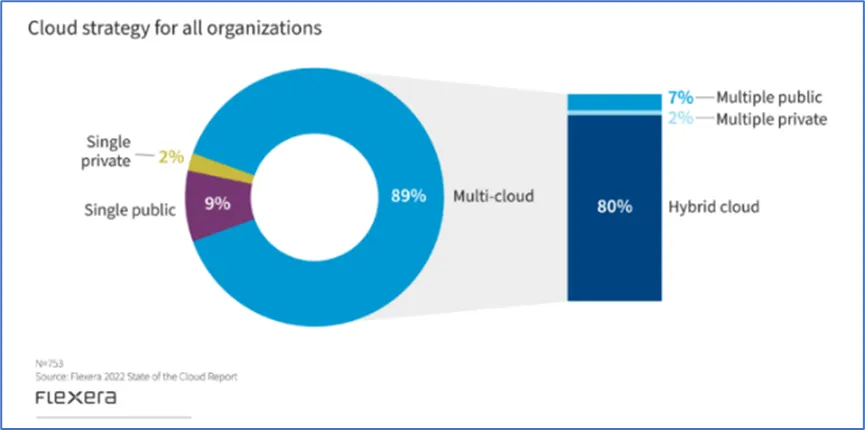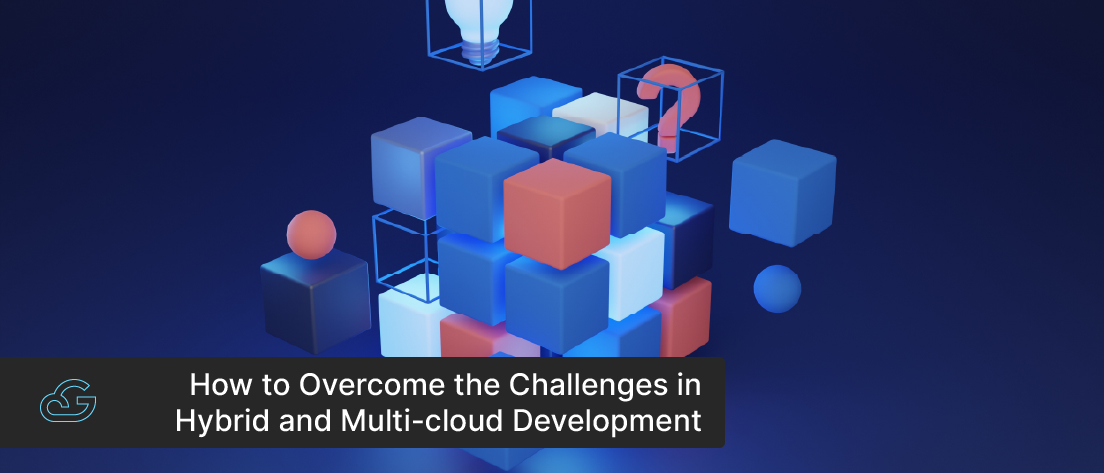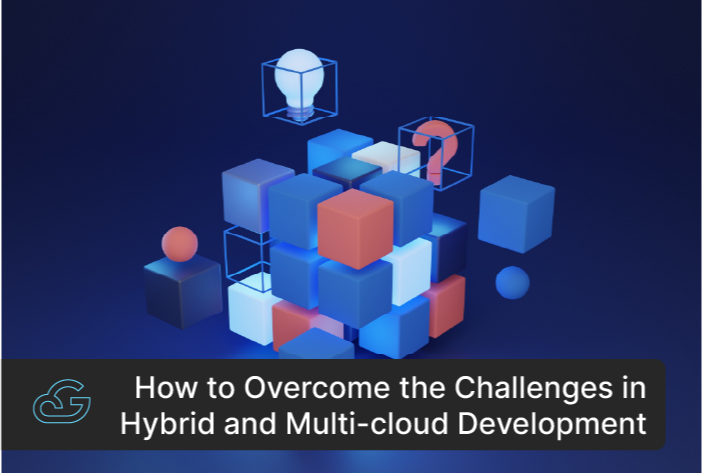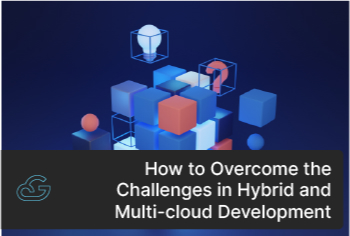Blogs / Hybrid and Multi-cloud
How To Overcome The Challenges In Hybrid & Multi-Cloud Development?
By
Harish K K [CTO]
Posted: June 20, 2022
• 4 Min Read
Hybrid and multi-cloud development have become increasingly popular in recent years, allowing organizations to take advantage of the benefits of multiple cloud providers, while still maintaining control over their data and applications. According to Flexera’s 2022 State of the Cloud Report, 89% of organizations across the world have already adopted multi-cloud strategy and out of that 80% is using a hybrid multi-cloud approach.

Enterprises are shifting their operations to cloud platforms for many reasons, such as evolving consumer behavior and extreme competition. While this shift is beneficial, there are also complexities associated with cost and security that could potentially derail the entire process. Therefore, before taking the first step, it's crucial to understand the key cost and security challenges associated with hybrid and multi-cloud development.
Let’s learn the common challenges that may arise in hybrid and multi-cloud development and how to tackle them effectively.
Challenges In Hybrid & Multi-Cloud Development
- Cost Challenge
-
Utilize cost optimization tools to monitor and manage resource usage across cloud providers, allocating resources in a way that optimizes costs. These tools can help you to identify areas where cost savings can be achieved.
-
Carefully plan the movement of data between cloud providers to minimize data transfer costs and ensure the maintenance of data privacy.
-
Use data storage and management services with low data transfer costs.
-
The type of license namely a per-user license, a per-server license, or a subscription-based license can also affect costs.
-
Additional licensing for resource scaling requirements to support increased usage and the new features and capabilities required by the application being developed.
-
Licensing for patented technologies to be purchased for using certain cloud platforms or tools that may be locked into a specific vendor. For instance, if the application requires advanced analytics or machine learning capabilities, developers may need to purchase licenses for those specific tools.
-
Use open-source software since it is often licensed under permissive terms that allow for use across platforms.
-
Consider cloud provider licensing options, such as AWS offering Bring Your Own License (BYOL) for certain software, to help reduce costs.
-
Negotiate with vendors to get better licensing deals, discounts for volume purchases or provide flexible licensing models that can help you reduce costs.
- Security Challenges
- Data Privacy
- Data Silos
- Data Movement
- Lack of Visibility
-
Implement strong data privacy policies and controls, including data encryption, access controls, and monitoring and auditing of data access and usage, that are applicable across all cloud platforms and on-premises infrastructure.
-
Work with cloud providers that have strong data privacy and security controls in place, and thoroughly evaluate compliance and regulatory requirements for each environment.
- Access Control
- Distributed Environment
- Multiple Access Methods
- Identity Management
- Security Risks
-
Implement a comprehensive access control strategy that takes into account the unique requirements of their hybrid or multi-cloud environment including measures such as centralized identity management, multi-factor authentication, Role-based access control, Encryption, Regular auditing and monitoring
- Compliance Challenge
- Cloud Environment
- Data Sovereignty
- Security Risks
-
Execute an extensive compliance strategy tailored for the requirements of your hybrid or multi-cloud environment. You can adopt measures such as Regular audits and assessments, Centralized compliance management, Compliance automation, Risk management, and Vendor management.
One of the most significant challenges associated with hybrid and multi-cloud development is managing costs. A cloud sprawl can occur when businesses face information silos and inadequate data governance and visibility, which can cause them to lose track of the hosting locations of their applications or result in inefficient operation of their applications. With many cloud providers involved, it is difficult to keep track of costs, and it's easy for costs to spiral out of control.
Some of the key cost challenges you should be aware of are :
Overprovisioning Cost
Over provisioning of cost is another challenge that you should be aware of. Due to the wide range ofdue to the wide range of pricing models, fees, and resource sizing options used by cloud vendors, businesses may accumulate high costs, particularly if they are not familiar with the various pricing options. Some cloud services are based on the consumption of compute resources, while others charge on a per-query basis for data scanned or based on bandwidth used.
Optimize Resource Allocation
Data Transfer Costs
Moving data between cloud providers can be expensive, especially when dealing with a substantial amount of data. The cost will depend on the location of the data and the cloud resources that are being used. For example, if the data is stored in one cloud region, and the cloud resources being used to process the data are in a different region, data transfer costs may apply. The cost may also arise due to the movement of data between cloud environments, or between the cloud and on-premises infrastructure and replicating data across cloud platforms for disaster recovery or high availability.
Plan for Data Movement
License Costs
In a hybrid or multi-cloud environment, developers may be using multiple cloud platforms, each of which may require its own license. The licensing cost may vary based on your specific requirements. Let’s check on some of the scenarios.
Rationalized Analysis of Licensing Terms and Tools/Technology Adoption
Hybrid and multi-cloud development presents some security challenges as well. With data and applications spread across cloud providers, it is hard to ensure consistent security measures. Let’s analyze some of the key security challenges you should be aware of.
You may encounter data privacy challenges due to the complicated and distributed nature of data storage and processing in these environments. Such scenarios can create problems, as cloud providers have their own data privacy policies.
Some of the key data privacy challenges include:
As your business grow you may need to create data silos when factors such as technology, organizational culture, and processes control or discourage the sharing of information. It keeps your data isolated from the rest of your technology ecosystem. Managing and securing data silos in a unified way, leading to potential privacy risks.
The risk of data leakage or exposure as data is processed, transferred over public networks, or through third-party connections, and moved between cloud platforms and on-premises infrastructure, poses a significant challenge in hybrid-multi-cloud development.
With data distributed across varied environments, it is challenging to maintain visibility into where sensitive data is located, who has access to it, and how it is being used. This can increase the risk of data breaches and other privacy incidents.
Unified Data Privacy Policies and Controls with Cross-platform Support
Controlling access to data and applications can create problems if cloud providers have different access control mechanisms. Below are some of the reasons why access control poses challenging in these environments.
Sometimes users may need to access resources that are distributed across cloud platforms and on-premises infrastructure, making it tricky to manage access control in a centralized and consistent way.
Each cloud platform and on-premises system may have its own access methods and protocols, which can make it challenging to provide a unified access control solution across all environments.
In a multi-cloud environment, managing user identities across cloud platforms is difficult and requires significant coordination.
With several access points and security policies in place, there is a risk of security vulnerabilities and breaches that can compromise data and applications.
Standardized Security Measures
Ensuring your applications and data are compliant with relevant regulations will be more troublesome if compliance requirements vary between cloud providers. Failure to comply with these regulations such as GDPR or HIPAA can result in significant legal and financial penalties.Some of the compliance change that may arise in hybrid-multi-cloud environment include the following:
As your cloud-based applications and data may be distributed across cloud platforms and on-premises infrastructure, managing and monitoring compliance in a centralized and consistent way may be turned to be challenging.
Your data may be stored in compound geographic locations, which can raise concerns about data sovereignty and compliance with local data protection laws.
Compliance is closely tied to security, and with separate access points and security policies in place,there is a risk of security vulnerabilities and breaches that can compromise compliance.
Comprehensive Compliance Strategy for Hybrid or Multi-Cloud Environments
Conclusion
To overcome any challenges, it's important to align your roadmap for building hybrid cloud capabilities with your goals for achieving business success. By taking a holistic approach and implementing these roadmaps together, you can equip yourself with the necessary tools to drive innovation and transform your business with a hybrid cloud as its foundation.
No matter where you are in your hybrid cloud journey, there is always an opportunity to optimize and transform your operations to fully leverage the benefits of hybrid and multi-cloud environments. With our expert guidance, support, and solutions, you can fully capture the value from it, which will drive your business forward and keep you stay ahead of the rest.
Contact our cloud experts today to learn more about how we can support your enterprise's hybrid and multi-cloud journey.


Get Know More About Our Services and Products
Reach to us if you have any queries on any of our products or Services.











